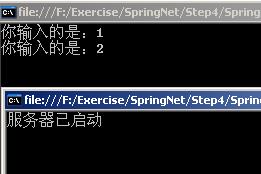Spring.NET学习笔记22——整合WCF(应用篇) Level 200
Spring.NET对WCF(Windows Communication Foundation)有很好的支持,Spring.Services程序集下封装了创建和调用WCF的方法。以往,我们使用svc文件来承载WCF;使用自动生产的代理来调用服务。这样便对产生了诸多依赖。而使用Spring.NET则会令应用程序得到良好的改善。
让我们从实例中学习今天的内容:
首先创建服务契约和其实现
 Contract
Contract
public interface IWcfContract
{
[OperationContract]
string GetData(int value);
}
public class ImplementService : IWcfContract
{
public string GetData(int value)
{
return "你输入的是:" + value;
}
}
把服务契约的实现类加入Spring.NET中管理
创建一个WCF的WCF项目,并引用Common.Logging.dll、Spring.Core.dll、Spring.Data.dll、Spring.Web.dll、Spring.Services.dll(在Spring.NET库下的3.0文件夹里)
Spring.ServiceModel.Activation.ServiceHostFactory类继承自System.ServiceModel.Activation.ServiceHostFactory,用于在BS架构中承载WCF。
建立svc文件
指定Service属性为服务契约的实现类(WcfServer)
配置web.config文件
 代码
代码
<services>
<service name="WcfServer" behaviorConfiguration="WcfServerBehavior">
<!-- Service Endpoints -->
<endpoint address="" binding="wsHttpBinding" contract="IContract.IWcfContract"/>
<endpoint address="mex" binding="mexHttpBinding" contract="IMetadataExchange"/>
</service>
</services>
<behaviors>
<serviceBehaviors>
<behavior name="WcfServerBehavior">
<!-- 为避免泄漏元数据信息,请在部署前将以下值设置为 false 并删除上面的元数据终结点-->
<serviceMetadata httpGetEnabled="true"/>
<!-- 要接收故障异常详细信息以进行调试,请将以下值设置为 true。在部署前设置为 false 以避免泄漏异常信息-->
<serviceDebug includeExceptionDetailInFaults="false"/>
</behavior>
</serviceBehaviors>
</behaviors>
</system.serviceModel>
指定Service节点的name属性为刚才配置的Spring.NET对象(WcfServer)。
在Global的Application_Start方法中实例化Spring.NET对象(Spring.Context.Support.ContextRegistry.GetContext();)
这样WEB宿主的WCF就搭建成功了。
而在winform或者控制台等程序中无法使用svc文件来承载WCF,但这一点被Spring.NET开发团队考虑到了。Spring.Services程序集下的Spring.ServiceModel.Activation.ServiceHostFactoryObject则是用于非WEB环境的WCF创建。
我们以控制台程序为例,来讲解在非WEB环境的WCF创建:
在控制台程序中创建一项Spring.NET对象的配置
<property name="TargetName" value="WcfServer" />
</object>
指明TargetName属性为实现服务契约的Spring.NET对象(WcfServer)
配置app.config文件,这里为了区别WEB环境,我使用netTcpBinding的绑定方式。
 代码
代码
<behaviors>
<serviceBehaviors>
<behavior name="WcfServerBehavior">
<!-- 为避免泄漏元数据信息,请在部署前将以下值设置为 false 并删除上面的元数据终结点-->
<serviceMetadata httpGetEnabled="true"/>
<!-- 要接收故障异常详细信息以进行调试,请将以下值设置为 true。在部署前设置为 false 以避免泄漏异常信息-->
<serviceDebug includeExceptionDetailInFaults="false"/>
</behavior>
</serviceBehaviors>
</behaviors>
<services>
<service name="WcfServer" behaviorConfiguration="WcfServerBehavior">
<endpoint binding="netTcpBinding" contract="IContract.IWcfContract"
bindingConfiguration="ServerBinding"
address="net.tcp://localhost:3286/App/Server/"/>
<endpoint address="mex" binding="mexHttpBinding" contract="IMetadataExchange" />
<host>
<baseAddresses>
<add baseAddress="http://localhost:3285/App/Server/"/>
</baseAddresses>
</host>
</service>
</services>
<bindings>
<netTcpBinding>
<binding name="ServerBinding">
<security mode="None">
<transport clientCredentialType="None" />
<message clientCredentialType="None" />
</security>
</binding>
</netTcpBinding>
</bindings>
</system.serviceModel>
指明baseAddress是为了便于生成WCF的代理类。
最后在控制台程序的Main方法中实例化Spring.NET容器,这样一个以控制台为宿主的WCF环境便搭建成功了。
然而对于调用WCF,我们通常使用“添加服务应用”的方式来生成WCF的代理类。这样,在整个项目都使用Spring.NET框架的环境下,很难管理WCF的代理类。
为了让Spring.NET来管理WCF的代理类,我们需要配置System.ServiceModel.ChannelFactory<T>这个泛型类,再配置代理类中的factory-method属性。
至于System.ServiceModel.ChannelFactory<T>类,是用来创建和管理客户端用来将消息发送到服务终结点的通道,这里不细讲,请查看MSDN。
 Client
Client
<object id="WebChannelFactory"
type="System.ServiceModel.ChannelFactory<IContract.IWcfContract>, System.ServiceModel">
<constructor-arg name="endpointConfigurationName" value="WSHttpBinding_IContract" />
</object>
<!--调用web宿主的代理类-->
<object id="WebProxy"
type="IContract.IWcfContract, IContract"
factory-object="WebChannelFactory"
factory-method="CreateChannel" singleton="false" />
<!--创建app宿主的信道工厂-->
<object id="AppChannelFactory"
type="System.ServiceModel.ChannelFactory<IContract.IWcfContract>, System.ServiceModel">
<constructor-arg name="endpointConfigurationName" value="NetTcpBinding_IContract" />
</object>
<!--调用app宿主的代理类-->
<object id="AppProxy"
type="IContract.IWcfContract, IContract"
factory-object="AppChannelFactory"
factory-method="CreateChannel"/>
注意的是System.ServiceModel.ChannelFactory<T>的构造函数中需要指明endpointConfigurationName属性为endpoint的name属性
 app.config
app.config
<endpoint address="http://localhost:3287/WebHost.svc" binding="wsHttpBinding"
bindingConfiguration="WSHttpBinding_IContract" contract="IContract.IWcfContract"
name="WSHttpBinding_IContract"/>
<endpoint address="net.tcp://localhost:3286/App/Server/" binding="netTcpBinding"
bindingConfiguration="NetTcpBinding_IContract" contract="IContract.IWcfContract"
name="NetTcpBinding_IContract"/>
</client>
客户端中调用WCF代理类
 Program
Program
{
static void Main(string[] args)
{
IApplicationContext cxt = ContextRegistry.GetContext();
//调用web宿主
IWcfContract webProxy = (IWcfContract)cxt.GetObject("WebProxy");
Console.WriteLine(webProxy.GetData(1));
//调用app宿主
IWcfContract appProxy = (IWcfContract)cxt.GetObject("AppProxy");
Console.WriteLine(appProxy.GetData(2));
Console.ReadLine();
}
}
程序运行的效果:







【推荐】国内首个AI IDE,深度理解中文开发场景,立即下载体验Trae
【推荐】编程新体验,更懂你的AI,立即体验豆包MarsCode编程助手
【推荐】抖音旗下AI助手豆包,你的智能百科全书,全免费不限次数
【推荐】轻量又高性能的 SSH 工具 IShell:AI 加持,快人一步
· 如何编写易于单元测试的代码
· 10年+ .NET Coder 心语,封装的思维:从隐藏、稳定开始理解其本质意义
· .NET Core 中如何实现缓存的预热?
· 从 HTTP 原因短语缺失研究 HTTP/2 和 HTTP/3 的设计差异
· AI与.NET技术实操系列:向量存储与相似性搜索在 .NET 中的实现
· 周边上新:园子的第一款马克杯温暖上架
· Open-Sora 2.0 重磅开源!
· 分享 3 个 .NET 开源的文件压缩处理库,助力快速实现文件压缩解压功能!
· Ollama——大语言模型本地部署的极速利器
· [AI/GPT/综述] AI Agent的设计模式综述